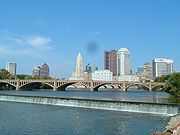.gif)
Main Street Bridge (Columbus)
Encyclopedia
The Main Street Bridge in Columbus
, Ohio
is a 700 ft (213.4 m), three-span, inclined arch
suspension bridge over the Scioto River
. The bridge is the first in North America
and only the fifth in the world to use an inclined arch superstructure. The final cost for the bridge was $60.1 million USD.
 The original Main Street bridge was a multiple-span, art-deco open-spandrel concrete deck arch bridge, built in 1937. After years of degradation due to weather and traffic, the bridge was deemed unfit for use and closed in 2000.
The original Main Street bridge was a multiple-span, art-deco open-spandrel concrete deck arch bridge, built in 1937. After years of degradation due to weather and traffic, the bridge was deemed unfit for use and closed in 2000.
Wanting an iconic structure to replace the old bridge, the city of Columbus contracted Dr. Spiro Pollalis, professor of design technology and management at the Harvard University Graduate School of Design to design the bridge. His design, altered slightly for budget reasons, was opened for traffic on July 30, 2010.
Columbus, Ohio
Columbus is the capital of and the largest city in the U.S. state of Ohio. The broader metropolitan area encompasses several counties and is the third largest in Ohio behind those of Cleveland and Cincinnati. Columbus is the third largest city in the American Midwest, and the fifteenth largest city...
, Ohio
Ohio
Ohio is a Midwestern state in the United States. The 34th largest state by area in the U.S.,it is the 7th‑most populous with over 11.5 million residents, containing several major American cities and seven metropolitan areas with populations of 500,000 or more.The state's capital is Columbus...
is a 700 ft (213.4 m), three-span, inclined arch
Arch bridge
An arch bridge is a bridge with abutments at each end shaped as a curved arch. Arch bridges work by transferring the weight of the bridge and its loads partially into a horizontal thrust restrained by the abutments at either side...
suspension bridge over the Scioto River
Scioto River
The Scioto River is a river in central and southern Ohio more than 231 miles in length. It rises in Auglaize County in west central Ohio, flows through Columbus, Ohio, where it collects its largest tributary, the Olentangy River, and meets the Ohio River at Portsmouth...
. The bridge is the first in North America
North America
North America is a continent wholly within the Northern Hemisphere and almost wholly within the Western Hemisphere. It is also considered a northern subcontinent of the Americas...
and only the fifth in the world to use an inclined arch superstructure. The final cost for the bridge was $60.1 million USD.
History

Wanting an iconic structure to replace the old bridge, the city of Columbus contracted Dr. Spiro Pollalis, professor of design technology and management at the Harvard University Graduate School of Design to design the bridge. His design, altered slightly for budget reasons, was opened for traffic on July 30, 2010.

